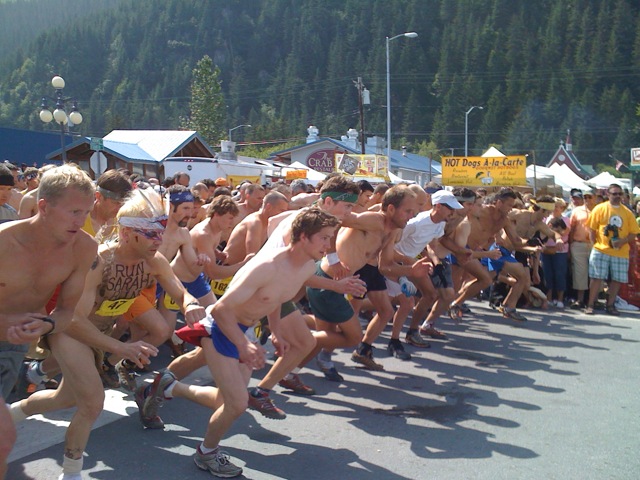Believe it or not, there are people out there are just starting to get into athletics for the first time in their lives. Some of them still find ski equipment intimidating, and fields of snow cold and loney. They stand by bewildered and call us "schralpers," "nodiks," and "stick twitchers." They don't get the inside jokes on johnnyklister.com and think Team Today has something to do with Lymphoma and purple t-shirts.
HomeCategory
Health
We aren’t doctors, and we try not to play one on the internet. But if we find health information that we feel affects cross-country skiers as a group, we do our best to pass it along.
The U.S. Cross Country Ski Team’s Kris Freeman had an outstanding year in 2009 as he earned two U.S. titles and a fourth place at World Championships. But, even with intense training for the 2010 Olympics at the forefront of his mind, Freeman is taking the time to speak to youth about Diabetes. A Type 1 diabetic, Freeman was told when he was diagnosed that he would have to end his career as an endurance...
Apparently it is too much to hope for a doping free season. Over the past month several doping scandals have made headlines. First, the FIS released the news that the urine sample provided by Russian sprinter Natalia Matveeva following the World Cup classic sprint in Whistler on January 16th tested positive for EPO. Despite initial reports that the B-sample would be tested within a week at the WADA lab in Quebec, no additional information has been forthcoming. Matveeva is provisionally...
Tour de Ski Set to Start!
Topher SabotDecember 26, 2008
The 3rd FIS Tour de Ski gets under way tomorrow. The event has become one of the big highlights of the long World Cup season, and features 7 races in 10 days. A mixture of sprints and distance races, as well as intermediate bonus points during the longer races means that the event favors all-around skiers over specialists. To win an athlete needs to be able to excel in both techniques over all distances and have the fitness to...
What Is the Proper Warm-Up?
FasterSkierNovember 7, 2008
The October 31st edition of the New York Times included an article by GRETCHEN REYNOLDS titled “Stretching: The Truth.” This piece examines stretching as part of a warm-up for exercise and presents significant evidence that static stretching not is not helpful, it may actually be harmful to performance. While focusing predominantly on sports like tennis and golf, the studies referenced are more general. Reynolds presents dynamic stretching as an alternative that is shown to increase...
Gatekeeper for Clean Sports
FasterSkierAugust 19, 2008
This is the fourth article in a series on doping from the Christian Science Monitor. Written by former elite US skier Christa Case Bryant, this piece profiles Don Caitlin, the man who created the test that broke BALCO, and headed the team that caught dopers Johan Muhlegg, Olga Danilova, and Larissa Lazutina at the 2002 Olympic Games. Caitlin is now working on a program to help athletes demonstrate that they are clean. Read the articles:...
The San Diego Union-Tribune reports that UCSD biology professor, Randy Johnson, has demonstrated that exposing the skin to various conditions – including low oxygen conditions – can stimulate the production of EPO in the body of mice. The researchers exposed the heads and bodies of mice to different levels of oxygen, leading to the conclusion that the skin, not just the internal organs, was triggering an increase in natural EPO. A spike in EPO production...
Secret “Coming of Age†ceremony revealed at Thunder Bay Ontario Cup race!
FasterSkierJanuary 24, 2008
Editor's Note: We're guessing that this article was submitted (by Frank Luckai of the Big Thunder Nordic Ski Club) after reading the recent article
Feeling Stiff From So Much Skiing: Try Incorporating this 10-Minute Flexibility Routine
FasterSkierDecember 22, 2007
NENSA.net has an extremely useful 10-minute stretching program designed specifically for Nordic skiers. This program targets large muscle groups; hips, ankles, shoulders, and trunk. Objective is to improve ski-specific body alignment through muscle stretching and joint flexion, improve stability through a range of motion, and equalize left-right muscle dominance patterns. This routine comes from the NENSA archives courtesy of Fred Griffin. The routine includes step-by-step instructions with photographs illustrating each stretch. www.nensa.net Source: NENSA
An Unexpected Reason to Train
Kevin BrookerDecember 15, 2007
If you’re like me, the idea of making time for regular exercise just because it’s good for you is not enough. There must be a goal motivating us to skip watching T.V. and go run in the rain. Drop a few pounds? What, are you nuts? Eating cake for breakfast and grabbing a few pretzels from the jar at each pass is no big deal. Stretching? Only for the remote. At the age of twenty-two...
Preparing for Altitude
FasterSkierNovember 15, 2007
Many elite athletes have used some form of altitude or hypoxic training to prepare for elite level competition. Likewise, many national level, elite, and recreational skiers are heading to moderate altitudes to train this fall and find early snow. Sovereign Lake race trails on Silver Star Mountain in British Columbia are at about 1600 m, West Yellowstone town is at 2030 m, and later this season some masters will compete at 1530 m in McCall,...
Editor's Note: While concussions are much more common in the various alpine disciplines, they do occur in cross-country skiing. This article provides useful guidelines for dealing with such occurances. Concussion is a very prevalent injury in snow sports. It is defined as a disturbance in the functioning of the brain following a blow to the head or a force transmitted to the head, which may or may not cause a loss of consciousness. This typically...
Commitment to a new cycling: Pat McQuaid meets professional continental teams
FasterSkierAugust 9, 2007
Editor's Note: As stated below, the UCI held a similar meeting in June, before the Tour de France. Many athletes and teams signed the “Commitment to a New Cycling,” including all four riders connected to doping in this year's Tour – Patrik Sinkewitz, Michael Rasmussen, Alexandre Vinokourov, and Cristian Moreni. This recent meeting was held with continental teams, while the earlier meeting was with ProTour teams. The President of the International Cycling Union, Pat McQuaid,...
Editors Note: FasterSkier.com is primarily a cross-country ski news source. However, we are providing coverage of the current doping issues at the Tour de France. As our readers know all too well, the use of banned substances is a significant issue in international cross-country ski racing. The events at the Tour provide insight into the current state of cheating in sport, and serve to remind us that this issue remains one of the largest challenges...
Editor's Note: FasterSkier.com is primarily a cross-country ski news source. However, we are providing coverage of the current doping issues at the Tour de France. As our readers know all to well, the use of banned substances is a significant issue in international cross-country ski racing. The events at the Tour provide insight into the current state of cheating in sport, and serve to remind us that this issue remains one of the largest challenges...
Editors Note: FasterSkier.com is primarily a cross-country ski news source. However, we are providing coverage of the current doping issues at the Tour de France. As our readers know all to well, the use of banned substances is a significant issue in international cross-country ski racing. The events at the Tour provide insight into the current state of cheating in sport, and serve to remind us that this issue remains one of the largest challenges...
Had enough of doping: German television cancels Tour du France coverage The German TV-channels ARD and ZDF cancelled their Tour de France coverage after it became known that T-Mobile rider Patrick Sinkewitz had tested positive for doping. Source: VG.no http://www1.vg.no/sport/sykkel/tour-de-france-2007/artikkel.php?artid=152971 The TV-channels made it very clear ahead of this year’s Tour de France that they would pack up and go home if a single rider was caught for doping in 2007. They now showed that...
Russian cross country hope banned for two years. It was in conjunction with an out-of-competition test earlier this summer that Irina Artemova tested positive in a doping test. The 23-year old Russian had illegal amounts of furosemide in her body. Artemova, who made her World Cup debut in 2004, is now banned from all competitions for two years. Source: Langrenn.com
As part of the revision of the World Anti-Doping Code, the regulations that define the practical conduct of testing, the International Standards, are also undergoing a thorough update as they become an obligatory part of the Code following the adoption of the new version in November 2007. The International Standards contain provisions related to the organization and practical aspects of testing, including athlete whereabouts requirements and sample collection procedures. FIS was requested by WADA to...


